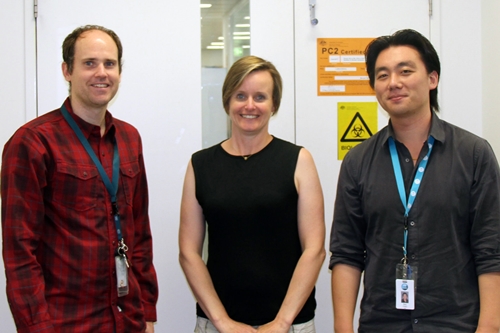
Research team members, L-R, Chad Heazlewood, senior author Susan Nilsson, and first author Benjamin Cao (CSIRO)
16 March 2016. A lab in Australia developed a process that makes it easier and faster to harvest blood-forming stem cells for treating diseases such as leukemia. The team led by Susan Nilsson at Monash University in Clayton, Victoria published its findings in yesterday’s (15 March) issue of the journal Nature Communications.
Transplants of hematopoietic or blood-forming stem cells are often used to treat blood-related cancers, such as leukemia or lymphoma, as well as other disorders of the blood and immune systems. Hematopoietic stem cells are created in bone marrow and transform into mature blood cells and some types of tissue cells. These stem cells do not transform or replicate on their own, however, which requires adding stimulants and growth factor proteins to the cells.
Among the stimulants often required to produce blood-forming stem cells are granulocyte colony-stimulating factors, proteins that encourage white blood cell growth, sometimes prescribed for patients receiving cancer chemotherapy. But these growth factors can cause serious adverse side effects, including bone pain and spleen enlargement. In addition, producing sufficient quantities of these stem cells requires multiple doses of growth factors and can take a number of days.
Another drug used to stimulate blood-forming stem cells in the needed quantities is AMD3100, an FDA-approved small molecule compound marketed as Mozobil by Sanofi. By itself, AMD3100 has few toxicity issues, but it often requires adding granulocyte colony-stimulating factors. Nilsson and colleagues, including associates from Germany and the U.S., sought a substitute for these growth factors that makes it easier for patients and takes less time.
Nilsson’s lab in the Australian Regenerative Medicine Institute at Monash earlier discovered another small-molecule compound that blocks proteins limiting production of blood-forming stem cells, known as N-(benzenesulfonyl)-L-prolyl-L–O-(1-pyrrolidinylcarbonyl)tyrosine), or BOP. In a study published in September 2015, she and colleagues showed BOP alone could stimulate blood-forming stem cell production, and possibly substitute for growth factors.
In the new study, the team tested BOP as a replacement for growth factors when added to AMD3100. The researchers tested a synthesized form of BOP with fluorescent properties to better track its efficacy, combined with AMD3100 on blood-forming stem cells in mice and human stem cells grown in mice.
The results show a single dose of BOP and AMD3100 successfully generated high production rates of blood-forming stem cells in both native and humanized mice. The combination of the two small-molecule compounds produced more stem cells than either of the compounds alone, and in as little as one hour.
The findings indicate the combination of BOP and AMD3100 offers a faster and potentially safer way to produce blood-forming stem cells. The next step, say the authors is an early-stage clinical trial testing the process with humans.
Read more:
- Multiple Myeloma Gene Therapy Trial Underway
- Biotech Reviewing Stanford Immuno-Stem Cell Technology
- Technique Devised to Improve Stem Cell Harvesting
- Trial Shows Vaccine Protects Against Stem Cell Complications
- USC, Biotech Edit Genes in Stem Cells for HIV Therapy
* * *

 RSS - Posts
RSS - Posts
You must be logged in to post a comment.